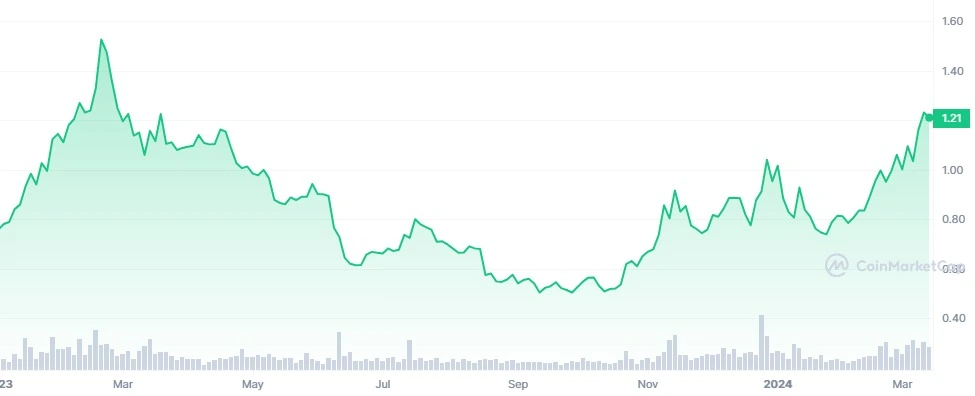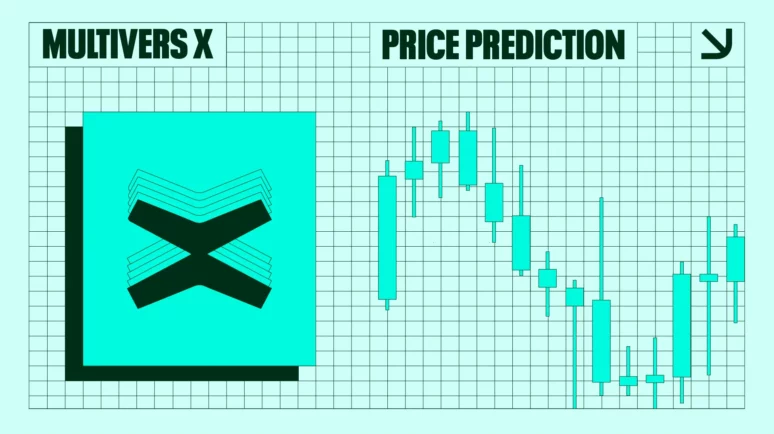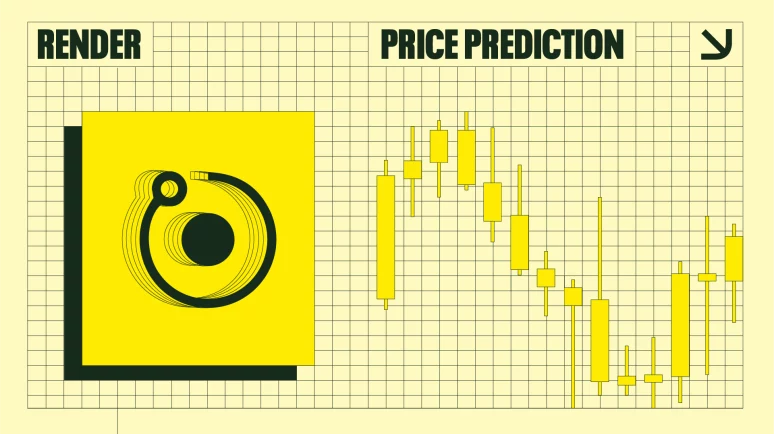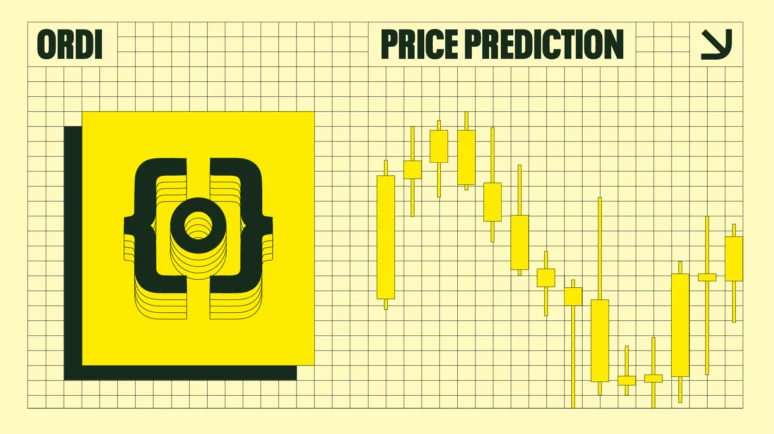Near Protocol Price Prediction 2024: Can NEAR Recover From Recent Losses?

What's next for NEAR?
Key Takeaways
- Near Protocol saw an increase in users in 2023.
- NEAR has fallen since peaking in December last year.
- NEAR is on the SEC’s hitlist, so what will happen next?
- One Near Protocol price prediction says NEAR can reach $30.41 next year.
The Near Protocol blockchain saw its users increase tenfold in 2023, with NEAT inscriptions launching in November. These served as the platform’s equivalent of non-fungible tokens (NFTs), helping attract people to the network.
In June last, Near Protocol – one of many systems set up to serve as some kind of rival to Ethereum (ETH) – announced that it would work with Alibaba Cloud, the computing and storage arm of Chinese tech giant Alibaba. This partnership would, potentially, see the system’s technology accessed by nearly one billion Alibaba customers. However, it dropped over the following months before making a recovery of sorts in October and November.
This upsurge was, in part, triggered by the KAIKAINOW platform, which allows people to access curated content without having to unlock their mobile phones.
NEAR recently lost part of its value after a positive end of 2023.
Near Protocol did not immediately respond to a request for comment.
But what is Near Protocol (NEAR)? How does Near Protocol work? Let’s see what we can find out, and also take a look at some of the Near Protocol Price Predictions that were being made as of March 13, 2024.
Near Protocol Coin Price Prediction
Let’s examine some of the Near Protocol price predictions being made on March 13. It is crucial to bear in mind that price forecasts, particularly for a potentially volatile asset like cryptocurrency, often turn out to be inaccurate. Additionally, please remember that many long-term crypto price predictions are generated using algorithms, which means they can change at any time.
| 2024 | 2025 | 2030 | |
|---|---|---|---|
| Prediction #1 | $17.96 | $20.77 | $60.41 |
| Prediction #2 | $10.62 | $15.73 | $114.12 |
| Prediction #3 | $22.41 | $30.41 | $70.43 |
First, CoinCodex had a short-term Near Protocol price prediction which said the crypto could rise to $10.64 by March 18 before recovering to $ 26.61 by April 12. The site’s technical analysis was bullish, with 26 indicators sending encouraging signals and four making bearish ones.
Near Protocol Price Prediction for 2024
DigitalCoinPrice said NEAR would get to $17.96 in 2024. PricePrediction.net was more cautious, saying it would reach an average of $10.62 then. Bitnation was more optimistic, with a Near Protocol price forecast that said it would reach $22.41 next year.
Near Protocol Price Prediction for 2025
Moving on, DigitalCoinPrice said NEAR could reach $20.77 next year. PricePrediction.net thought it would get to $15.73 then. Bitnation thought it would be worth $30.41 in 2025
Near Protocol Price Prediction for 2030
Regarding a more long-term Near Protocol price prediction, Bitnation suggested it could trade at $70.43 in 2030. DigitalCoinPrice set a figure of $60.41 that year. PricePrediction.net’s NEAR price prediction said it could reach $114.12 by the start of the next decade.
Google BardAI Price Prediction for Near Protocol (as of March 13)
Google’s BardAI platform gave the following price prediction for Near Protocol on March 13. Please remember that the exact price prediction of an asset or cryptocurrency in the future is nearly impossible to achieve. Additionally, artificial intelligence price predictions are predicated on past performances and are in no way entirely accurate.
Short-Term (Next 3 Months):
- Expected Price: $15.98
- Factors to Consider:
- Market Sentiment: Currently, there’s a bullish sentiment surrounding NEAR, but the Fear & Greed Index indicates “Extreme Greed,” which could precede a correction.
- Technical Indicators: While these can be helpful, they shouldn’t be the sole factor in your decision-making.
- Overall Market Conditions: The broader cryptocurrency market significantly impacts individual token prices.
Medium-Term (Next 6 Months):
- Expected Price: $19.71
- Factors to Consider:
- Market sentiment: Right now, there seems to be “Extreme Greed” in the market according to Changelly, which could lead to a correction.
- News and developments: Near Protocol’s future partnerships, technological advancements, and overall crypto market trends will all influence the price.
Long-Term (Next 5 Years):
- Expected Price: $33.27
- Factors to Consider:
- Market Sentiment: Bullish sentiment can drive prices up, while bearish sentiment can lead to drops.
- Adoption and Use Cases: Increased adoption of NEAR for things like DeFi or NFTs could positively affect its price.
- Regulations: Government regulations surrounding cryptocurrency can impact its overall market health.
Advantages and Disadvantages of Near Protocol
Blockchain analytics company Messari recently released its quarterly report on Near Protocol. In it, they outlined some key advantages and disadvantages to the blockchain.
Messari found that Near Protocol:
- Had 868,800 active daily addresses, up from 63,700 year-on-year and up from 257,500 quarter-on-quarter.
- Had an average market cap of $3.7 billion, up from $1.1 billion both year-on-year and quarter-on-quarter from $1.3 billion.
- Made $751,500 in revenue, up from $157,900 the previous year and up from $107,500 the previous quarter.
- Had 2.4 million daily transactions, up year-on-year from 400,000 and up from 700,000 quarter-on-quarter.
Advantages of Near Protocol
Messari said that
- NEAR had outperformed the crypto market
- Was working well on becoming more decentralized.
- Had cashed in on NEAR inscriptions.
Disadvantages of Near Protocol
Messari also said that
- NEAR would have to deal with being accused of serving as an unregistered security by the SEC.
- Could still make its platform easier to use.
- Was pretty undiverse, with more than 90% of its DeFi activity taking place across four platforms.
NEAR Price History
Let’s now take a look at some of the highlights and lowlights of the Near Protocol price history . While past performance should never be taken as an indicator of future results, knowing what the coin has done can help give us some very useful context when it comes to either making or interpreting a Near Protocol price prediction.
When NEAR first came onto the open market in late 2020, it was worth about $1.70. The first few months of 2021 were highly bullish for both NEAR and crypto, with the coin shooting up to trade at $7.31 in the middle of March.
After that, things went down for a while, but there was a recovery later on in the year. It broke past $10 in September but fell back down in December before mounting a fightback to close the year at $14.60.
While 2021 was a very positive year for the coin, 2022 was less so. It didn’t look like that initially, though, as NEAR shot up to new levels, reaching an all-time high of $20.42 on January 16. While it fell back down the next month, it came back and was close to $20 in April.
After that, though, things started to go wrong. The market collapsed, and NEAR dropped below $10 in May, below $5 in June, and, following the bankruptcy of the FTX exchange, below $2 in November. It closed the year at $1.27, an annual loss of more than 90%.
Near Protocol in 2023 and 2024

Things went better in 2023. The coin rallied, breaking past $2.50 in February. However, the news that the SEC considered NEAR to be an unregistered security saw it collapse from $1.65 to $1.14 on June 5.
By June 26, things had got a little better, and the coin reached $1.61. After that, though, it fell again. By October 13, it was worth $0.9988. Since then, it has recovered and, on November 3, 2023, it was worth about $1.50. Over the next month or so, NEAR went on an upward climb, albeit with some peaks and troughs, reaching a peak of $4.60 on December 26. It closed the year at $3.65, an annual rise of more than 185%.
The coin fell in early 2024 and, on March 13, 2024, it was worth about $1.21.
At that time, there were a 9.9 billion NEAR in circulation, out of a total supply of 10.0 billion. This gave it a market cap of about $2.2 billion, making it the 32nd-largest crypto by that metric.
Near Protocol Price Analysis

Between January 2022 and October 2023, NEAR was in a bear market, falling from a peak of $20 in January 2022 into a multi-year downturn.
Subsequently, it embarked on an upward trajectory, surging over 670% to reach a high of $8.50 on March 13, 2024. This high is the continuation of an uptrend that started on January 23, when NEAR made a retracement to $2.40.
Judging from the wave structure, this is its wave three out of the five-wave pattern. On the daily chart, the Relative Strength Index is at an overbought zone above 82%, suggesting a correction is likely to follow. NEAR should start developing its fourth wave soon. Then, it should go below $6. If it manages to stay above that level, another upward advance could bring it to a higher high of $11.
Recent Updates from Near Protocol
The Near Foundation joined the Stacks network as a Signer and to support the growth of a new economy on top of Bitcoin.
Is Near Protocol a Good Investment?
It is hard to say. We still don’t know if NEAT will gain any traction. The news that it is to team up with Alibaba is certainly encouraging, as it could help give the system usage to a company whose customers might not bother with crypto. Any increase in a platform’s utility and prominence should benefit its native token, and NEAR responded well to events. The KAKINOW screen lock platform has also helped bring new users to Near Protocol.
On the other hand, Near Protocol is living under the shadow of the SEC’s claim that it is an unregistered security. Not only that but, considering that it is one of the sorts of blockchains to be dubbed an “Ethereum Killer”, the overall health of ETH might lead someone to wonder whether Near Protocol might not be getting the sort of attention it could.
As always with crypto, you will need to do your research before deciding whether or not to invest in NEAR.
Will Near Protocol go up or down?
No one knows for sure. While the price predictions are broadly optimistic, price predictions are usually wrong. Also, remember that prices can, and do, go down as well as up.
Should I invest in Near Protocol?
Before you decide whether or not to invest in Near Protocol, you should do your research, not only on NEAR, but on other, similar coins and tokens, such as Ethereum, Cardano (ADA), and Solana (SOL). You must also make sure that you never invest more money than you can afford to lose.
Who are the founders of Near Protocol?
Crypto entrepreneurs Illia Polosukhin and Alexander Skidanov founded the Near Protocol in 2017. Polosukhin previously worked for Google’s artificial intelligence department, while Skidanov was an engineer for Microsoft.
Who owns the most Near Protocol (NEAR)?
On March 13, 2024, a wallet held 10.77% of the supply of NEAR.
Richest NEAR Wallet Addresses
As of March 13, 2024, the five wallets with the most NEAR were
- 0x0000000000000000000000000000000000001004. This wallet held 1,141,885 NEAR, or 10.77% of the supply.
- 0x1a34f9f7a8252a9381cec640a1c03355bdead42b. This wallet held 590,732 NEAR or 5.57% of the supply.
- 0x21d45650db732ce5df77685d6021d7d5d1da807f. This wallet held 373,056 NEAR or 3.52% of the supply.
- 0xaf36ff4504afe98c4661a39960adc6b3b10abe00. This wallet held 283,974 NEAR or 2.68% of the supply.
- 0x91dca37856240e5e1906222ec79278b16420dc92. This wallet held 239,800 NEAR, or 2.26% of the supply.
Fact Box
| Supply and distribution | Figures |
|---|---|
| Total supply | 10,000,000,000 |
| Circulating supply (as of March 13,2024) | 9,899,116,344 (98.99% of total supply) |
| Holder distribution | Top 10 holders own 30% of supply (as of March 13, 2024) |
From the Whitepaper
According to Near Protocol’s technical documentation, or whitepaper , the platform is designed to help people build, develop, and grow applications.
It says: “NEAR is built from the ground up to deliver intuitive experiences for end users, scale capacity across millions of devices, and provide developers with new and sustainable business models for their applications. In doing so, NEAR is creating the only community-run cloud strong enough to extend the reach of Open Finance and power the future of the Open Web.”
Near Protocol (NEAR) Explained
Near Protocol is a blockchain that aims to be faster than the average, thus saving people time and money if they want to do things. Founded in 2017 by crypto entrepreneurs, it aims to deliver the quickest speeds available.
Based on a platform called Doomslug, the protocol can add blocks to the blockchain after just one round of validation, significantly fewer than many of its rivals.
Something else that it does a bit differently is that, rather than having a wallet address consisting of a string of numbers and letters, it allows people to have a “human readable” name. The idea behind this is that, by doing so, the system is more user-friendly and, potentially, easier for people who aren’t highly experienced with blockchain technology to pick up.
Near Protocol also supports the creation of decentralized applications (DApps).
The system has its crypto coin, NEAR.
How Near Protocol Works
As well as its Doomslug technology, Near Protocol uses a process called sharding and, in particular, Nightshade sharding. Put simply, this means that the blockchain is broken into smaller segments, which means that it is, at least in theory, quicker.
Rather than being controlled by either a normal business or one single decentralized autonomous organization (DAO), Near Protocol is split into seven departments, called guilds, which operate as independent DAOs.
The NEAR coin itself is used to govern the network, with holders able to vote on proposals affecting the system’s future, and it can also be bought, sold, and traded on exchanges. Because Near Protocol uses a Proof-of-Stake consensus mechanism, holders can add blocks to the blockchain and earn rewards based on how much NEAR they have.
Near Protocol Attention Tracker

Here is a chart for the Near Protocol Google search volume for the past 90 days. This represents how many times the term “Near Protocol” has been Googled over the previous 90 days.
FAQs
Will Near Protocol reach $10?
It could well as all main price predictions expect it to reach a double-digits value this year.
What is Near Protocol used for?
NEAR is the native token of the Near Protocol blockchain. It is used to give people the right to vote on changes to the network and to add blocks to the blockchain. It can also be bought, sold, and traded on exchanges.
Disclaimer
Please note that the contents of this article are not financial or investing advice. The information provided in this article is the author’s opinion only and should not be considered as offering trading or investing recommendations. We do not make any warranties about the completeness, reliability, and accuracy of this information. The cryptocurrency market suffers from high volatility and occasional arbitrary movements. Any investor, trader, or regular crypto user should research multiple viewpoints and be familiar with all local regulations before committing to an investment.


